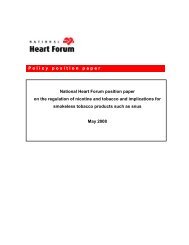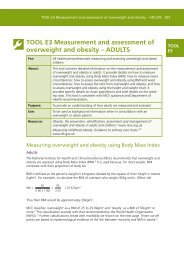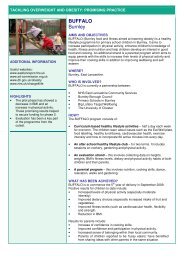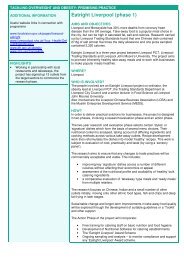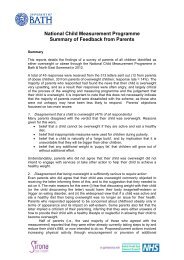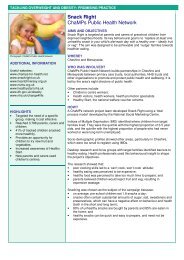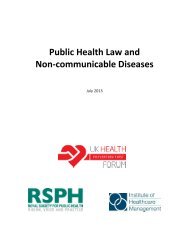The Challenge of Non-Communicable Diseases and Road Traffic ...
The Challenge of Non-Communicable Diseases and Road Traffic ...
The Challenge of Non-Communicable Diseases and Road Traffic ...
Create successful ePaper yourself
Turn your PDF publications into a flip-book with our unique Google optimized e-Paper software.
An Overview 37<br />
clarity <strong>of</strong> vision <strong>and</strong> purpose, emphasizing common<br />
elements, <strong>and</strong> facilitating efficient <strong>and</strong> effective use <strong>of</strong><br />
resources [200, 205]), the reality <strong>of</strong> individual countries<br />
may be that a mixture <strong>of</strong> policies, programs,<br />
<strong>and</strong> interventions are already in place, as was found<br />
in the case in Ghana <strong>and</strong> Cameroon, [192, 206]. A<br />
meeting <strong>of</strong> SSA health leaders in 2009 suggested the<br />
value <strong>of</strong> having a generic NCD plan which integrates<br />
palliative care, surveillance, <strong>and</strong> the reduction <strong>of</strong> risk<br />
factors, alongside disease-specific plans that take account<br />
<strong>of</strong> specific issues in individual diseases (such<br />
as diagnosis <strong>and</strong> treatment) [207]. <strong>The</strong> challenge is<br />
to find a good model that fits a specific context <strong>and</strong><br />
the specificities <strong>of</strong> SSA [179], <strong>and</strong> focus on achieving<br />
outcomes. First Implementing a priority set <strong>of</strong> interventions,<br />
such as tobacco control <strong>and</strong> salt reduction<br />
measures, before adopting a more comprehensive<br />
approach, has been proposed lest starting with a<br />
comprehensive plan is too ambitious, <strong>and</strong> risks diverting<br />
resources from moving ahead quickly with<br />
the most productive actions [208].<br />
<strong>The</strong>re has also been debate over the place for ‘vertical’<br />
(st<strong>and</strong>-alone) programs in health systems [209],<br />
<strong>and</strong> concern that establishing new vertical programs<br />
for NCDs <strong>and</strong> RTIs in resource-constrained countries<br />
risks placing them in direct competition for scarce<br />
funding with existing programs such as those on communicable<br />
diseases <strong>and</strong> maternal <strong>and</strong> child health,<br />
which is likely to be unsustainable [210]. Both advantages<br />
<strong>and</strong> limitations <strong>of</strong> ‘vertical’, disease-specific programs<br />
have been recognized, with calls for the lessons<br />
learnt to be applied [211-212]. Further research has<br />
been proposed to ascertain what ‘integration’ would<br />
really mean in different settings <strong>and</strong> for different<br />
services [144], <strong>and</strong> instead <strong>of</strong> a false dichotomy between<br />
so-called vertical <strong>and</strong> horizontal approaches,<br />
analytical <strong>and</strong> conceptual frameworks have been proposed<br />
to help shift the debate <strong>and</strong> reframe the issues<br />
[213-214]: for example ‘diagonal’ programs have been<br />
proposed whereby disease-specific interventions are<br />
designed to minimize the untoward impact on other<br />
health programs, <strong>and</strong>/or support health systems<br />
more. Similarly, rather than refer to specific disease<br />
categories, there have also been proposals to rethink<br />
health systems to be better able to encompass all diseases,<br />
with a greater emphasis on primary health care<br />
<strong>and</strong> community-based interventions [215-217].<br />
While donor-driven <strong>and</strong> global health initiatives<br />
have mobilized substantial new resources for health<br />
in many LMIC, there is a recognized challenge to<br />
combine disease-specific programs with broader<br />
approaches for health improvement so that positive<br />
synergies are capitalized upon <strong>and</strong> negative impacts<br />
minimized [218-219]. Any approach involving<br />
greater integration or ‘diagonalization’ may meet<br />
with resistance if it appears to take control away<br />
from donors <strong>and</strong> proponents <strong>of</strong> vertical programs<br />
[215], or if it undermines existing programs <strong>and</strong><br />
their broader benefits [220], or fails to take account<br />
<strong>of</strong> lessons learnt [221]. Both potential negative impact<br />
(loss <strong>of</strong> funding <strong>and</strong> <strong>of</strong> political attention) <strong>and</strong><br />
positive impact (a greater commitment to investing<br />
in health care for chronic diseases) have been seen as<br />
potential outcomes. Nevertheless, there is increasing<br />
enthusiasm for leveraging HIV resources, experience,<br />
<strong>and</strong> models for the benefit <strong>of</strong> other chronic<br />
conditions, <strong>and</strong> to ‘jumpstart’ initiatives to provide<br />
prevention, care, <strong>and</strong> treatment services for them [5,<br />
142, 222-225]. After all – on grounds equity <strong>and</strong> efficiency<br />
– some argue that there is no basis for HIV/<br />
AIDS care to be better resourced than care for other<br />
chronic conditions, such as diabetes.<br />
5.2. Population-Level Prevention<br />
Population-level interventions are not reliant on<br />
health services for delivery: costs are relatively low<br />
<strong>and</strong> they may even generate funds; they have relatively<br />
little “downside”; most people will be exposed<br />
to them; <strong>and</strong> people who are at high risk or already<br />
suffering from NCDs will benefit [226]. Population-level<br />
prevention, particularly in resource-limited<br />
countries, benefit from a strong regulatory <strong>and</strong><br />
fiscal framework, particularly for tobacco control.<br />
Most cost-effective measures to reduce risk factors<br />
are in the domain <strong>of</strong> agencies or ministries other<br />
than health, such as ministries <strong>of</strong> trade, finance, agriculture,<br />
<strong>and</strong> transport, but may challenge vested interests<br />
<strong>and</strong> face strong lobbying by tobacco, alcohol,<br />
<strong>and</strong> other industries. <strong>The</strong>refore, while they include<br />
some <strong>of</strong> the cheapest <strong>and</strong> most effective interventions<br />
(such as tobacco <strong>and</strong> alcohol taxation), they<br />
may be politically difficult to achieve, requiring robust,<br />
high-level leadership <strong>and</strong>/or effective impacts<br />
to build partnerships <strong>and</strong> garner broad support.



